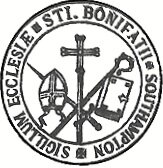
Advent and Christmas at St Boniface Tin Church 1909-1913
Father Thomas Byrne
Father Thomas Byrne wrote in the Catholic Magazine several pieces for the Catholic community at St Boniface, Foundry Lane, Southampton for Advent.
“Christ came unto his own and His own received him not. People now don’t want Him. He is not wanted in Parliament; in society there is no room for him, for Society has discovered it can get on better without Him and His religion which is out of date and dull. The four friends who are intimately associated with Jesus are Humility, Poverty, Purity and Chastity”
“During Advent we prepare for Christmas. The Church’s Advent message to us is the message preached to the Jews by our Lord’s predecessor: Prepare ye the way of the Lord, make straight his path; do penance. Penance is the necessary preparation for his coming at Christmas. The Catholic who consciously remains during Christmas tide in a state of mortal sin cannot possibly have a happy Christmas.”
“Advent was formerly observed like a second Lent and there are still a few fasting days left during Advent. Pope St Gregory the Great appears to have made this observance a universal law for the whole church at the end of the 6th century although Advent was already at the time kept in various places”
FEAST DAYS IN ADVENT
“December 1st- Festival of the English Martyrs, Blessed Edmund Campion and his companions executed 1 December 1581.”
“December 3rd - Feast of St Francis Xavier, Patron of the Association for the Propagation of the Faith. During Advent an opportunity is given to all to give a penny or two for this work after Sunday masses. This collection is distinct from that taken on the Epiphany for the African missions under the charge of the French White Fathers ordered by Leo X111.”
“December 5th- Day appointed for the General Communion of members of the Apostleship of Prayer”
“December 8th- Festival of the Immaculate Conception of Our Lady, patroness of the diocese”
“December 13th- The feast of St Lucy”
POEM “ALONG THE WAY” by J Buckham
(Suggested for Advent contemplations)
There are so many helpful things to do along life’s way
(Helps to the Helper, if we but knew) from day to day!
So many troubled hearts to soothe,
So many pathways rough to smooth,
So many comforting words to say
To hearts that falter along the way.
Here is a lamp of hope gone out along the way.
Someone stumbled and fell, no doubt- But brother, stay!
Out of thy store of oil refill;
Kindle the courage that smoulders still;
Think what Jesus would do, today,
For one who had fallen beside the way.
How many lifted hands still plead, along life’s way!
The old sad story of human need reads on for aye.
But let us follow the Saviour’s plan-
Love unstinted to every man!
Content if, at most, the world should say:
“He helped his brother along the way”.
THE NEW HYMNBOOK
On September 1st 1910 the Bishops of England and Wales decreed that the only hymns to be sung in Catholic Churches were to be from the agreed list. This was followed soon by the version complete with the melody (tune) parts and was called “The Westminster Hymnal”.
Copies were only given to the choir; the congregation could buy their own but at 6d not many people could afford one.
Christmas 1910 was the test of this new hymn book. Christmas carols were known by heart by the people so when the hymn “Angels we have heard on high” was announced, the words had been changed in several places in the new hymnbook.. The result was that the choir sang the new version while the people sang the words of their old favourite!
THANKS TO THE PEOPLE WHO HELPED AT THE CHURCH
Father Sander, who was German, bought from Germany a wonderful crib with wax figures.
Mrs Sarah Wosikowski (the church caretaker) made new vestments and renewed the felt covering of the sanctuary.
Many parishioners were thanked for providing the evergreens and plants and palm trees used to decorate the church!

Designs for Decorating your Church
Published Advent 1914
“Lo! Now is come our joyful’st feast!
Let everyman be jolly
Each room with ivy leaves is drest
And every post with holly!”
“In churches the very note should be dignity and solemnity without gloom but with beauty and cheerfulness”
Decorations should be symbolical.
Madonna Lilies are excellent also thorns and brambles
Fishing nets should be used where a curtain is needed. Greenery can be woven into them.
The altar should have pure white and blood red flowers.
Palm trees should be freely used to give height to floral decorations.
Pillars should have wreaths of evergreens winding up and down or in straight lines from top to bottom.
Ferns and chrysanthemums should be placed at each pillar base with deep fringes of laurel dropping from the top. Christmas roses made from paper are woven in.
Windows to be dressed solely in box leaves with 3 swags (loops) under each sill. Evergreen to be placed on all ledges
Verses to be strung across walls e.g. Hodie Christus Natus Est (Christ is born today) and Gloria In Excelsis Deo (Glory to God in the highest).
These were made out of three layers of cardboard glued together using Gothic (Black Letter) script.
Special letters were to be in yellow or red, the others being in dark yew green. The verses are picked out in red berries and yew leaves.
